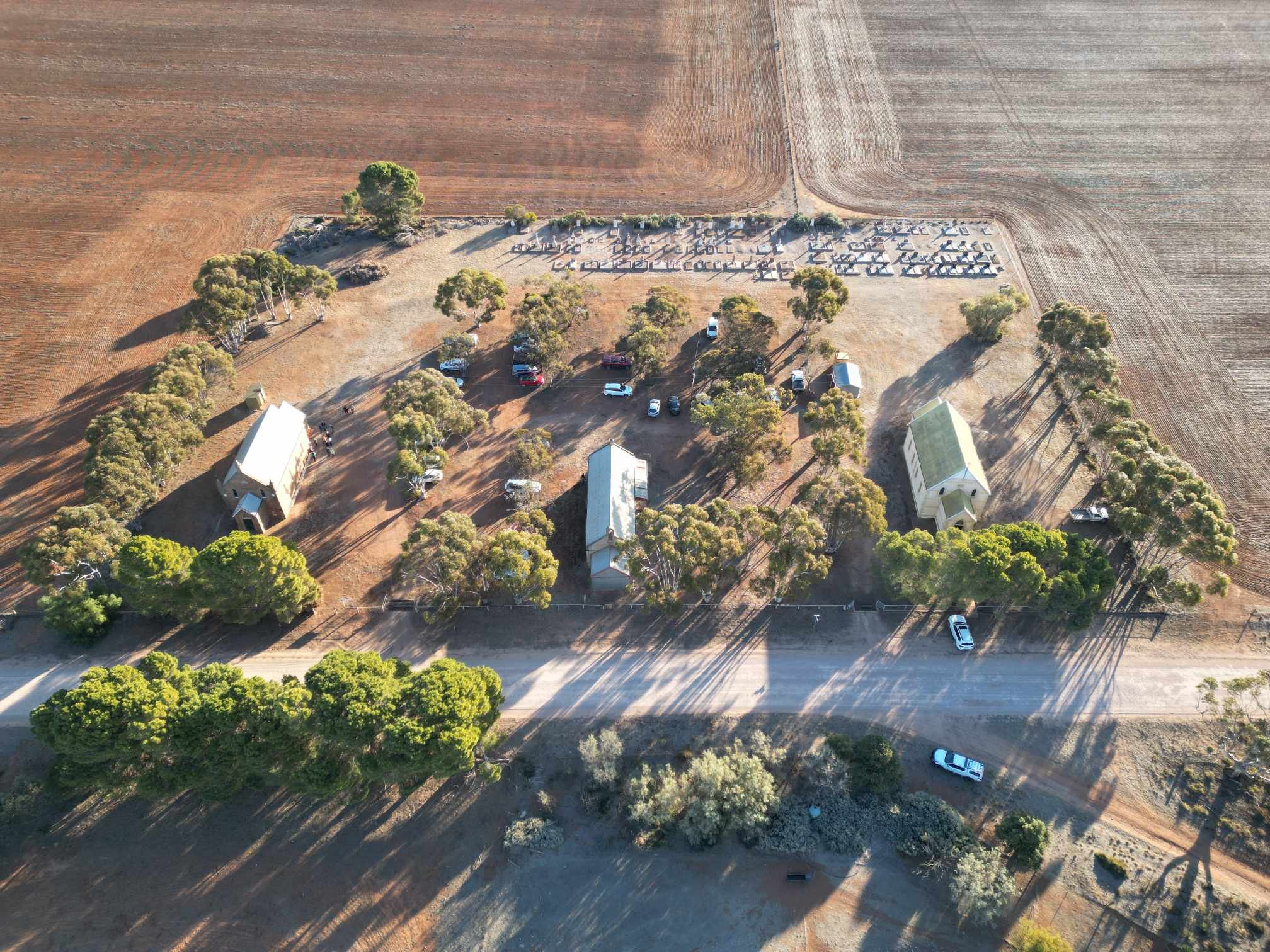A Tale of Faith and Friction at Neales Flat
Samuel Doering speaking in the original St. Paul's Church, also used as a school from 1874 to 1942.
Three of Neales Flat's churches in one image. L-R: St. John's, built 1912; the old St. Paul's/school, built 1874; and the new St. Paul's/Trinity, built 1893.
Throughout May and June 2024, hundreds of visitors travelled to Neales Flat, South Australia, to learn about the equally bemusing and outrageous story of Lutheranism in the area. Cheekily titled ‘Don’t Argue With Germans,’ the 90-minute walking tours were led by historian, Samuel Doering (Associate Historian, PHA SA) and originally offered during South Australia’s History Festival in May. Guests learned about the many arguments that led to the construction of four church buildings.
Neales Flat is a sparsely populated farming district, making the feat of four church buildings quite unusual. Three of the church buildings stand on the same piece of land, a feat that may be unrivalled in all of Australia. The fourth church building was constructed two kilometres away. Among the earliest European settlers who arrived from 1866 after the area was surveyed were German Lutherans from the Barossa Valley who brought their faith and traditions with them. Two of the four church buildings were constructed in 1874 because of the growing local population.
Guests started in the original St. Paul’s Lutheran Church, which also served as a school from 1874 to 1942. Its foundation stone was laid by Pastor E. D. Appelt. Samuel explained how the building functioned as a school by relying on the written memories of former scholars who recorded arriving at school and lining up to salute the flag and sing the National Anthem before marching into school and awaiting the roll call then commencing lessons. Others recounted walking long distances to school, punishments for misbehaviour, and schoolyard shenanigans. German was the main language of instruction until 1917, when it became a state school. A blackboard in the school contains names of former scholars who held reunions there seven decades after its closure.
The building operated as the St. Paul’s Church until 1893, when a larger building was constructed next door to fit the growing congregation. Samuel led the group a few steps across the church yard to the second St. Paul’s building and continued the story.
Here Samuel explained that in 1895 disagreements within the Evangelical Lutheran Synod of Australia (ELSA), spurred by disagreements with the Hermannsburg Mission Society, led to the formation of independent congregations. Pastor Franz Hossfeld's expulsion from the ELSA in 1895 led him to form an independent church that included St. Paul's. A minority in the congregation disagreed with Hossfeld’s opinions, so formed their own congregation which was loyal to the ELSA. The split in the congregation led to a punch-up between members of opposing congregations, which appeared in the Magistrate’s Court in Eudunda in August 1895.
Members of the St. Paul’s congregation who left in 1895 later formed the St. John’s congregation. Further disputes between St. John’s and St. Paul’s in 1904 led to the erection of fences in the cemetery (there are examples of husbands and wives being buried separately) and the construction of an additional school. The St. John’s congregation built a church in 1912, which was the third stop during the afternoon. Samuel recounted the history of St. John’s, including its connection to Pastor Theodor Nickel, a controversial figure in Lutheran history.
While guests were comfortably seated in the building, which today serves as the place of worship for the Neales Flat Lutheran Church, Samuel explained another facet of the area’s Lutheran history. Two kilometres east of the three churches is situated St. Stephan's, another church building, which traces its origins to 1871, and belonged to another branch of the Lutheran community.
The three congregations, St. John’s, St. Paul’s, and St. Stephan’s, operated nearly independently until 1966, when a church-wide amalgamation came into effect. St. John’s and St. Paul’s formed the new Trinity Congregation, while St. Stephen’s remained a single congregation. Today, the descendants of these various congregations all worship together in the former St. John’s building, known as the Neales Flat Worship Centre, which was reconsecrated in 2009 following a major shift in the use of church properties.
Visitors left with a fresh understanding for the rich tapestry of faith and history woven into the fabric of Neales Flat, where three churches stand as silent witnesses to a community's passionate commitment to their Lutheran faith.
Samuel Doering, PHA SA


